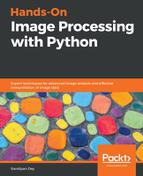The following code block defines a function, fit_generative_model(), that takes as input a training set (x data and y labels) and fits a Gaussian generative model to it. It returns the following parameters of this generative model—for each label, j = 0,1,...,9, we have the following:
- πj: The frequency of the label (that is, the prior)
- μj: The 784-dimensional mean vector
- ∑j: The 784 x 784 covariance matrix
This means that π is a 10 x 1, μ is a 10 x 784, and ∑ is a 10 x 784 x 784 matrix. The Maximum Likelihood Estimates (MLE) for the parameters are the empirical estimates, as shown in the following diagram:

The empirical covariances are very likely to be singular (or close to singular), which means that we won't be able to do calculations with them. Hence, it is important to regularize these matrices. The standard way of doing this is to add c*I to them, where c is some constant and I is the 784-dimensional identity matrix (to put it another way, we compute the empirical covariances and then increase their diagonal entries by some constant c).
This modification is guaranteed to yield covariance matrices that are non-singular, for any c > 0, no matter how small. Now, c becomes a (regularization) parameter and, by setting it appropriately, we can improve the performance of the model. We should choose a good value of c. Crucially, this needs to be done using the training set alone, by setting aside part of the training set as a validation set or using some kind of cross-validation—we leave this as an exercise for the reader to complete. In particular, the display_char() function will be used to visualize the means of the Gaussians for the first three digits:
def display_char(image):
plt.imshow(np.reshape(image, (28,28)), cmap=plt.cm.gray)
plt.axis('off')
plt.show()
def fit_generative_model(x,y):
k = 10 # labels 0,1,...,k-1
d = (x.shape)[1] # number of features
mu = np.zeros((k,d))
sigma = np.zeros((k,d,d))
pi = np.zeros(k)
c = 3500 #10000 #1000 #100 #10 #0.1 #1e9
for label in range(k):
indices = (y == label)
pi[label] = sum(indices) / float(len(y))
mu[label] = np.mean(x[indices,:], axis=0)
sigma[label] = np.cov(x[indices,:], rowvar=0, bias=1) + c*np.eye(d)
return mu, sigma, pi
mu, sigma, pi = fit_generative_model(train_data, train_labels)
display_char(mu[0])
display_char(mu[1])
display_char(mu[2])
The following screenshot shows the output of the preceding code block—the MLE of the means for the first three digits:

